上海新世纪版高二年级第二学期-Unit 2 Making Speeches- 课件(共63张PPT)
文档属性
| 名称 | 上海新世纪版高二年级第二学期-Unit 2 Making Speeches- 课件(共63张PPT) |

|
|
| 格式 | zip | ||
| 文件大小 | 1.5MB | ||
| 资源类型 | 教案 | ||
| 版本资源 | 上海新世纪版 | ||
| 科目 | 英语 | ||
| 更新时间 | 2020-02-24 20:55:23 | ||
图片预览


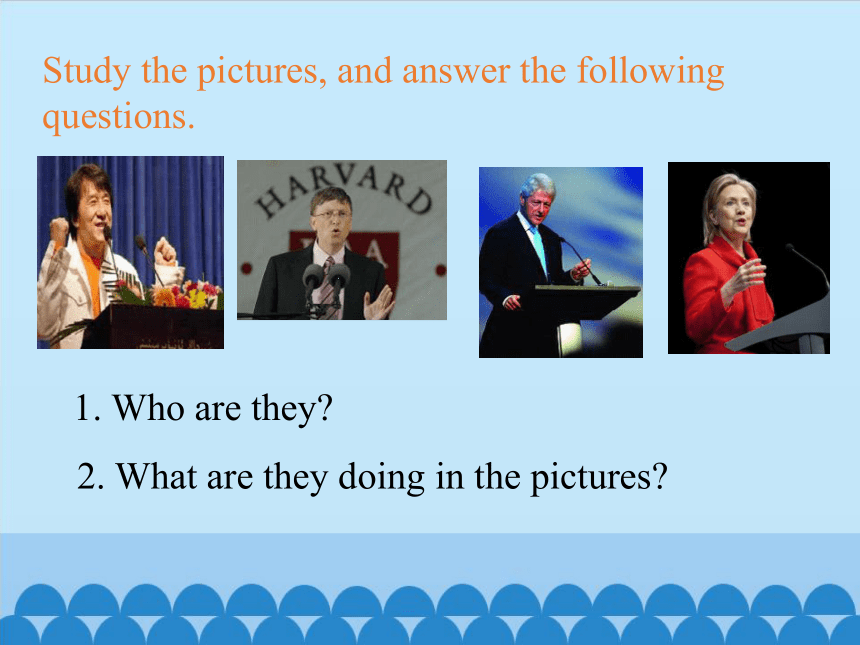

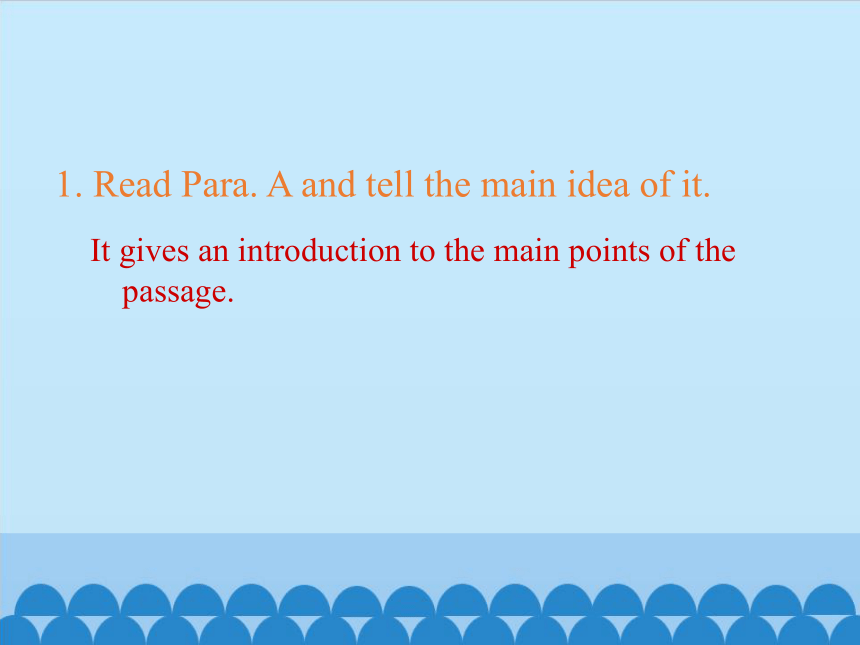

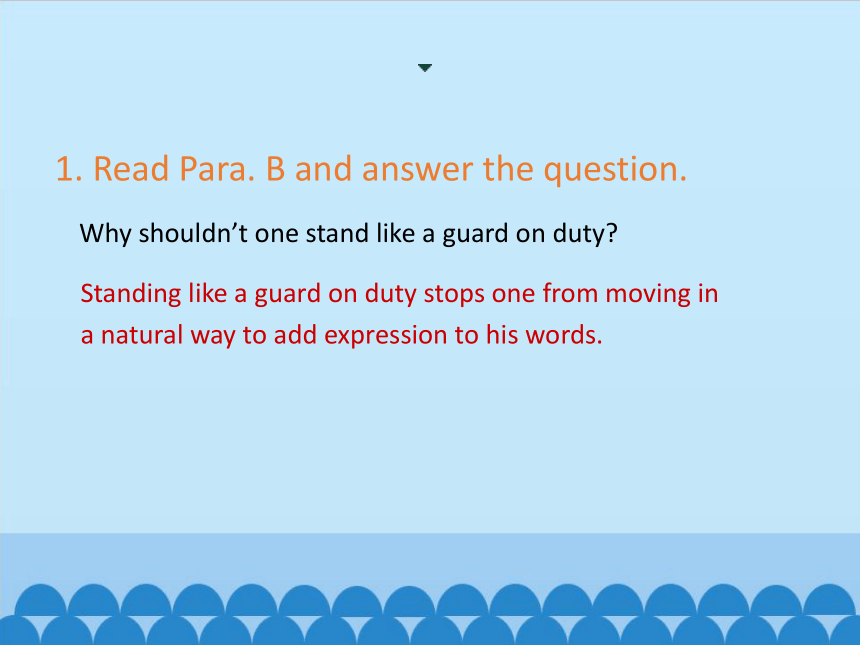
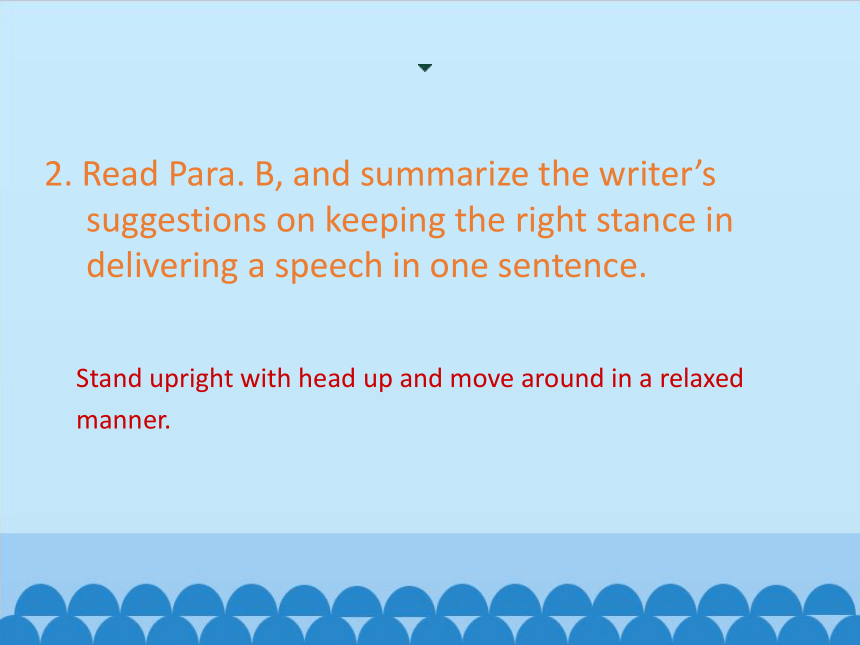
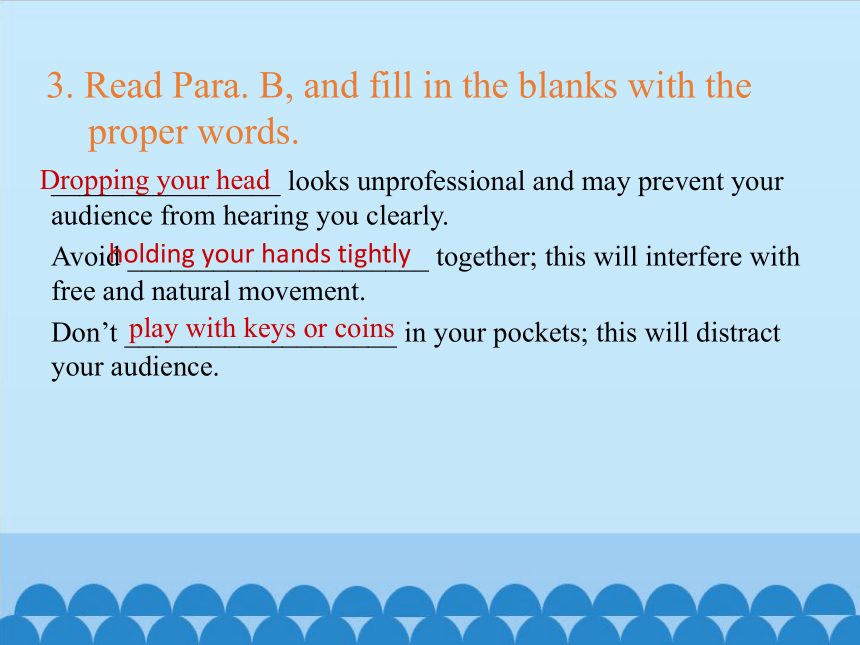
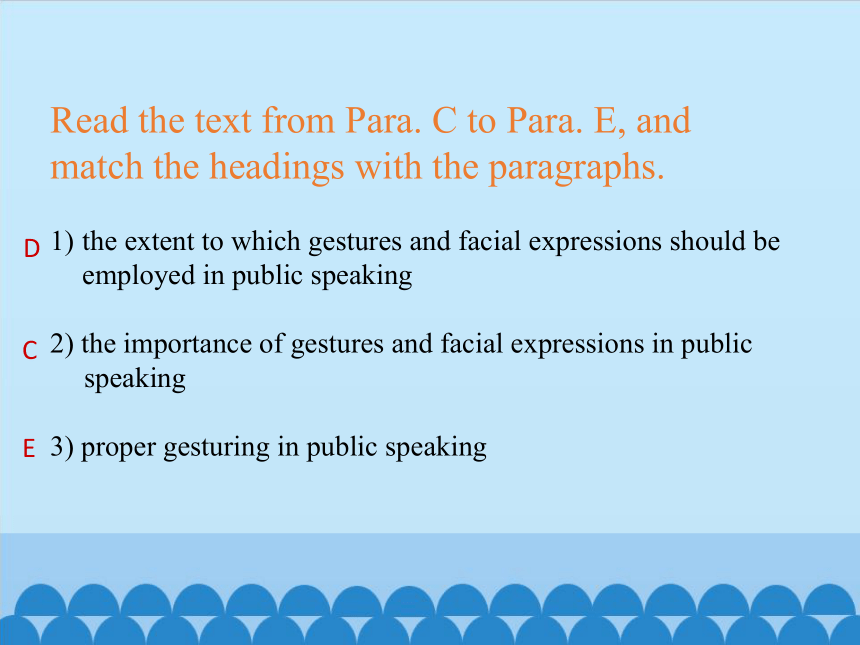
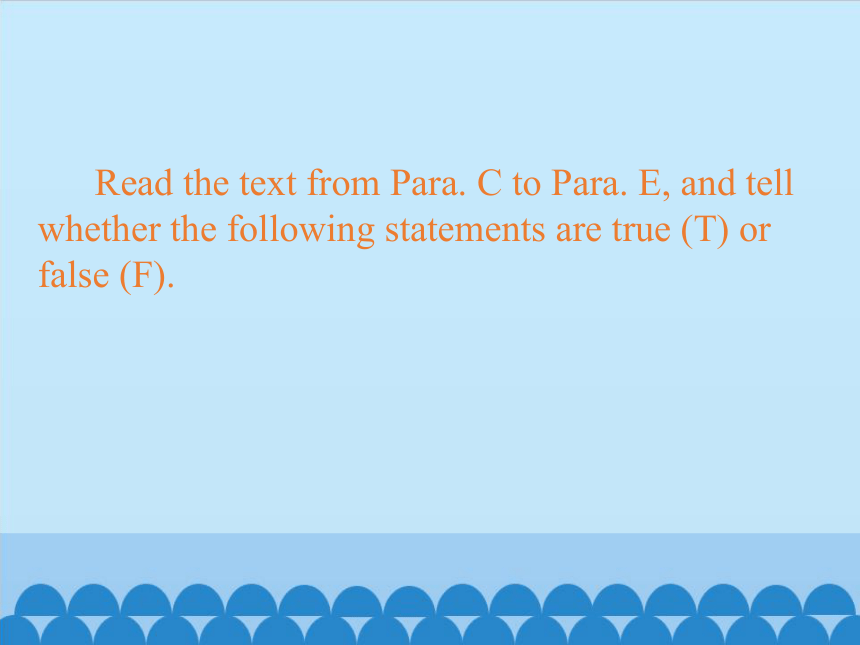

文档简介
(共63张PPT)
Unit 2 Making Speeches
Lesson 1
Study the pictures, and answer the following questions.
1. Who are they?
2. What are they doing in the pictures?
Skim the text quickly and answer the question.
In how many aspects is the writer going to give tips on
making a public speech?
The writer is going to present his tips in four aspects —
stance, gestures, eye contact, and timing.
1. Read Para. A and tell the main idea of it.
It gives an introduction to the main points of the passage.
2. Read Para. A and answer the question.
To make an effective public speech, one must take into
consideration verbal and nonverbal communication, a clear
statement of the message one would like to express.
To make an effective public speech, what factors must
one take into consideration?
Text understanding-task4.1
1. Read Para. B and answer the question.
Standing like a guard on duty stops one from moving in
a natural way to add expression to his words.
Why shouldn’t one stand like a guard on duty?
Text understanding-task4.1
2. Read Para. B, and summarize the writer’s suggestions on keeping the right stance in delivering a speech in one sentence.
Stand upright with head up and move around in a relaxed
manner.
3. Read Para. B, and fill in the blanks with the proper words.
play with keys or coins
________________ looks unprofessional and may prevent your audience from hearing you clearly.
Avoid _____________________ together; this will interfere with free and natural movement.
Don’t ___________________ in your pockets; this will distract your audience.
Dropping your head
holding your hands tightly
Read the text from Para. C to Para. E, and
match the headings with the paragraphs.
D
C
E
3) proper gesturing in public speaking
2) the importance of gestures and facial expressions in public speaking
the extent to which gestures and facial expressions should be employed in public speaking
Read the text from Para. C to Para. E, and tell whether the following statements are true (T) or false (F).
3) Telling a funny story with a very serious face is a technique many humorists use to achieve a special effect.
T
F
F
1) Facial expressions are more important than gestures when we address a large audience.
2) Expansive gestures are particularly effective in drawing the attention of a large audience.
5) In a large group, facial expressions will add a lot to understanding.
4) Make sure that the gestures are not repeated too often.
F
T
Read the text from Para. F to Para. G, and answer the questions.
To glance towards all sections of the audience and don't be afraid to move your head.
1. How can you make each member of your audience feel
as if you were speaking to them personally?
2. What does accurate timing involve?
Accurate timing involves a proper speed of talking and a proper length of your talk.
3. In Para. G, what does “Either way” refer to?
It refers to falling short of the time or running over the time.
Please make a dialogue according to the text.
Lesson 2
The Given Situation:
A speech contest will be held in our school next
Monday. You will take part in the contest on behalf of your
class. These days you’re busy preparing for it. Now you
have some trouble and you want to turn to your teacher
for help.
An example:
Student: Hello, Mrs./Mr. … I’m going to take part in the speech contest next Monday. I need your help.
Teacher: O.K.
Student: What should I pay attention to if I want to make a good speech?
Teacher: As we all know, body language plays a very important role in a speech. So I suggest that you should not only pay enough attention to your body language but also to your audience’s.
Tips on Making a Public Speech
It is interesting to note that speeches are always “given” or “delivered”. They are never “said”. When giving a speech, therefore, it is useful to think of yourself as playing a part, i.e. acting. This kind of acting calls for an integration of verbal and nonverbal communication. Nonverbal communication chiefly involves the speaker’s stance and gestures, the eye contact between the speaker and the audience, and a good control of the presentation speed of talking/speaking.
A
Stance
This is important to the delivery of a good speech. Stand up straight and keep your head up. Dropping your head looks unprofessional and may prevent your audience from hearing you clearly. On the other hand, don’t stand like a guard on duty. You have to be able to move in a natural way in order to add expression to your words. Body language “says” a lot. Avoid holding your hands tightly together; this will interfere with free and natural movement. Don’t play with keys or coins in your pocket; this will distract your audience.
B
Gestures
Gestures and facial expressions are both important aids to the spoken word when you are communicating. A dull, long speech delivered without expression, without gestures or eye contact will not be well received. The skill is in deciding how much gesturing to be employed and in making sure that your gestures are natural.
In general, the larger the audience, the more expansive the gestures should be, because they will not be seen so clearly by the audience. In a small group, facial expressions will add a lot to understanding. Try telling somebody something funny with a very serious face. They will have difficulty believing what you are really saying is funny.
C
D
Different gestures are supposed to be used in delivering a speech. Some people use their hands a lot when speaking. You must make sure that your gestures are not repeated too often, and they should be expressive and meaningful.
Eye Contact
To have maximum impact you need to make each member of your audience feel as if you were speaking to them personally. To do this, glance towards all sections of the audience and don’t be afraid to move your head. If you favour one direction, the other side may feel you are ignoring them and therefore lose interest in what you are saying.
E
F
Timing
Accurate timing is essential. You should ensure that you don’t fall short of or run over the time allowed for your speech. Either way, the audience will feel unhappy and lose concentration on your speech. The best way to overcome this is through preparation. Clear thinking about what you want to say and how long your speech will last, before you start to write it, will save a lot of time. When practising, make sure that you speak at the correct speed and do time yourself.
G
deliver vt. 发表(讲话等)
make/give/deliver a speech 作演讲
e.g.
The Queen delivers a speech every year.
Don’t worry. I will teach you some tips on delivering a public speech.
女王每年都要作一次演讲。
别紧张,我会教你一些作公共演讲的技巧的。
vt. 投递
e.g.
The little boy delivers newspapers twice a day.
Leaflets have been delivered to every household.
这个小男孩每天送两次报纸。
传单已经发送到每家每户。
delivery n. 传送,递送;演讲方式,表演风格
e.g.
I’ll charge myself with the safe delivery of the secret information.
The strike caused a great delay in the delivery of the mail.
我来负责安全递送这个秘密情报。
这次罢工导致了邮件投递的重大延误。
Practice:
1. 你的牛奶是让别人送的吗? (deliver)
2. 大多数的当地餐厅提供免费的送餐服务。 (delivery)
Do you have your milk delivered?
Most local restaurants offer free delivery.
e.g.
Please pay for goods on delivery.
The beautiful poetry was ruined by his poor delivery.
请货到付款。
这首优美的诗被他拙劣的朗诵给糟蹋了。
I had to give a slow delivery.
我不得不慢慢地说。
Practice:
1. He ________ (向……保证) me that he would finish his
work on time.
2. My house is _______ (投保) against fire.
3. Please ______ (确保) all the children live a happy life.
assured
insured
ensure
Lesson 3
Keep it Short for the Audience’s Sake
How long should I make my speech? How long will my audience concentrate on my speech? How slowly should I speak to make myself clearly understood? In trying to answer these questions, we see how important timing is to speech.
A
Keep your speech less than 15 minutes
Lin Yutang, the famous writer and translator, once said about the length of a speech, “the shorter, the better.” Speaking around the topic should be seriously avoided, not only in speech, but in all conversations in English. Being indirect and roundabout in your approach may be thought skillful in Chinese. But in English speech? No way. When one is making a speech in English, he should always stick to the point, and use simple, clear and direct language.
According to scientists, audiences can generally only manage to concentrate for about 13 minutes. So a 10-15-minute speech is about right.
B
C
The famous Gettysburg Address, delivered by Abraham Lincoln on November 19, 1863 has about 200 words, but it still managed to express the idea that all people are born equal.
150-160 words per minute
Speaking speed often depends on the occasion for the speech. The number of people in the audience is also an important factor to be considered.
If you are speaking to hundreds or even thousands of people, especially in the open air, you should speak slowly. The idea is to let the audience catch every single word of your speech. For example, when Martin Luther King spoke, even to a small group, his usual speaking speed was only 110 to 120 words per minute.
D
E
F
When you are speaking indoors to a small group, say, 10 or 20 people, you may speed up a bit. Speaking at a speed of around 200 words a minute, you can still retain the audience’s attention.
So, we can see that the average speed is about 150 to 160 words per minute.
Whether you are speaking slowly or rapidly, the important point is to pronounce every word clearly. Otherwise, no matter how wonderful you think your content is, the audience won’t be able to follow you. Use phonetic symbols to mark the places you often mess up, in advance, and practise every day before you get up on stage.
G
H
I
Pause for dramatic effect
If you want a particular sentence or expression to leave a deep impression on your audience, you can pause a while before uttering it. During the pause, the audience will grow curious about why you choose to pause and they will anxiously expect to hear the next sentence, which is exactly what you want to happen.
But don’t pause too frequently or too long. Eye contact and a smile, with a bit of body language, will also effectively impress your audience. If you simply stop suddenly and remain silent for several seconds before you start again, they’ll probably think, “Oh, he (she) has forgotten the words!”
J
K
e.g.
He moved to the country for the sake of his daughter’s health.
Mother reluctantly agreed to go to the party for her son’s sake.
for one’s sake / for the sake of sb.
为了……的利益 为了……起见
为了女儿的健康,他把家搬到了乡村。
妈妈为了儿子勉强同意去参加聚会。
Practice:
1. 请打印这份报告吧,就算是为了我。(sake)
2. 为了孩子们,这对夫妇做了三份兼职。(sake)
Please type the report for my sake.
The couple has three part-time jobs for the sake of the children.
e.g.
I explained the plan again to make myself clearly understood.
He raised his voice in order to make himself heard.
make oneself done
让自己被……
为了让大家明白,我又解释了一遍这个计划。
为了让别人听见,他提高了嗓音。
Practice:
1. 在作演讲时,你要恰当使用眼神交流以使自己被别人理解。
(make oneself done)
2. 老师详细地讲述了这个故事,以便让学生们理解。
(make oneself done)
While making a speech, you should use eye contact properly to make yourself understood.
The teacher told the students the story in details in order to make himself understood.
Lesson 4
Moods and feelings
A 1 You are going to hear two dialogues between Sally and Mike. The boy and the girl in the pictures below are Mike and Sally. Dialogue 1 and Picture 1 are about Mike’s holiday; Dialogue 2 and Picture 2 are about a football match.
1
2
Mike looks surprised. It seems he doesn’t believe what has happened. Sally looks happy about the match — maybe her team has won.
Before listening to the dialogues, look at the two pictures and make predictions about what you are going to hear with the help of the following questions.
(1) Is Mike having a nice holiday or an unhappy one? How do
you know?
(2) What does Mike think of the football match? What about
Sally?
From Mike’s facial expressions, we can tell he is having a wonderful holiday.
Listen to the dialogues and decide whether each of the following statements is true (T) or false (F).
(3) Sally and Mike support the same football team.
F
T
T
(1) Sally thinks that Mike is lucky to have a holiday.
(2) Linda is not happy about Mike going off on his own for
a few days.
(4) Sally doesn’t think highly of her team performance yesterday.
F
Dialogue 1
Mike: Hi, Sally!
Sally: Hello, Mike. You look happy.
Mike: Yes, I am.
Sally: Why’s up?
Mike: Well, I’m on holiday.
Sally: Really? Lucky you!
Mike: Yes, and I’m going off on my own for a few days.
Sally: How nice! But what about Linda?
Mike: Oh, Linda doesn’t mind.
Dialogue 2
Sally: Our football team beat the Tiger yesterday.
Mike: Really? I can hardly believe that. They’ve never won the whole season, and the Tiger has got the best chance to be the champion of the year.
Sally: I’m not kidding. Our team played marvelously in the game yesterday. The score was 3:0.
Mike: Oh, no! This is too good to be true.
Perhaps you think of Mark Twain as a great American writer. He was also well known for his ability as a speaker. Here is a story about how he became a good speaker. When he first began to speak in public, Twain used a full page of notes. He would write down the beginnings of the key sentences. For an evening’s lecture, he would write and memorize eleven key sentences. The plan failed. Twain would remember the sentences all right, but forget their order. He would have to stop, look at his notes, and thus he would stop many times in the middle of his lecture and that made his listeners feel unhappy. Later Mark Twain came up with a great idea. He found that it was hard to see
letters, words and sentences clearly during the talk, but pictures were easy to remember, especially if you drew them yourself. Twain was not an artist, but that did not stop him. “In two minutes, I made six pictures with a pen,” he said, “and they did the work of those eleven sentences, and did it perfectly.” Having once drawn the pictures, he found he could throw them away. He discovered that he could memorize their images quite well. From then on, Twain was able to speak without notes.
Do’s and don’ts
B1 In public speaking, we should pay attention to both verbal and nonverbal communication. Discuss with your partner and make a list of “do’s and don’ts” for VERBAL COMMUNICATION and NONVERBAL COMMUNICATION.
◆VERBAL COMMUNICATION
e.g.
Keep your speech well-structured.
Try to stress the parts you want to emphasize.
Don’t read from your script (手稿).
Don’t talk too fast or too slowly.
…
◆ NONVERBAL COMMUNICATION
e.g.
Keep your head up and keep your back straight.
Glance towards all sections of the audience to make them feel as if you were speaking to them personally.
Don’t drop your head or cover your face with your script.
Don’t fall short of or run over the time allowed for your speech.
…
*Compare your notes with those of two other pairs of students and make your list as long as possible!
Moods and feelings (2)
B2 Listen to the two dialogues in A1 of “Listening practice” again. Work in pairs and act out the dialogues. In acting, pay attention to proper gestures and facial expressions.
1. I’m very pleased with your performance.
2. I’m so happy that you have recovered.
3. I’m delighted to hear that.
4. Oh, super!
5. That’s marvelous!
6. That’s excellent!
Useful Language:
Dealing with moods and feelings
Expressing delight
1. Really?
2. What?
3. My goodness!
4. How amazing!
5. Incredible! / That’s incredible!
6. No, I can’t believe it.
7. Are you kidding? / You’re kidding me!
Expressing surprise
1. How right you are!
2. I absolutely agree.
3. I can’t help thinking the same as you.
4. I couldn’t agree more.
5. I quite agree with you.
6. I suppose so.
7. Oh, exactly.
8. You know that’s exactly what I think.
Expressing agreeing
1. How annoying!
2. Don’t talk to me about that fellow.
3. I really hate being kept waiting.
4. Impossible. This is too much.
5. What a nuisance!
6. It really makes me mad.
7. I simply can’t bear.
8. It makes me sick the way he laughs.
Expressing anger
1. Excuse me.
2. I really am so sorry.
3. I’m afraid I’ve brought you too much trouble.
4. I’m awfully sorry. I didn’t realize it.
5. I’m sorry, it was all my fault.
6. I’m terribly sorry. I didn’t mean to hurt your feelings.
7. Pardon me.
8. It was really quite unintentional.
Expressing apology
1. How wise of you!
2. I think I would accept that.
3. I’m sure you are right.
4. I’m very pleased about your arrangement.
5. It was a sensible idea, I felt.
6. That’ just what I’m getting at.
7. That’s an excellent idea.
8. The decision is absolutely right.
Expressing approval
1. I wish I knew more about the truth.
2. I wish someone would tell me the secret.
3. I wonder if you could tell me the reason.
4. I’d like to know how they managed to escape.
5. It must be wonderful being just married, isn’t it?
6. If only I knew about it.
7. What’s in your mind?
8. I’m most curious about the new invention.
Expressing curiosity
1. His decision is a great pity.
2. I was rather disappointed.
3. I was very disappointed at the new house.
4. I’m sorry to hear about his failure in the examination.
5. It wasn’t as good as I’d expected.
6. It’s disappointing!
7. What a pity.
8. What a shame!
Expressing disappointment
How exciting!
How wonderful to hear the news!
I find it very exciting.
Super!
Terrific!
I’m very excited by the story.
That sounds like fun.
What a great idea!
Expressing excitement
1. I don’t feel happy at all.
2. I feel very miserable.
3. I feel such an idiot.
4. Oh, I don’t know. I’m just a bit depressed.
5. Oh, no! How could this happen to me!
6. Really. I’m just feeling a bit low.
7. What’s the use of doing these things?
8. I could kick myself.
Expressing dismal feelings
1. I can’t find words to express how much I like it.
2. I fancy that dress.
3. Walking is a marvelous way of killing time.
4. I’m mad about dancing.
5. I really hate gossiping.
6. I find it difficult to get on with your brother.
7. Horrible, isn’t it?
8. That sort of music is rubbish.
Expressing likes and dislikes
1. I’m scared of mice.
2. I fear that he may have lost his way.
3. I’m extremely nervous of my trip abroad being canceled.
4. I’m very anxious.
5. I’m very concerned about her illness.
6. Their absence upsets me very much.
7. I do hope he is all right.
8. I find the situation very worrying.
Expressing worry or fear
Prepare a short speech and present it to the class. Then the class make comments on the speech in terms of its length, the topic, the language, and the use of the body language.
Thank you!
Unit 2 Making Speeches
Lesson 1
Study the pictures, and answer the following questions.
1. Who are they?
2. What are they doing in the pictures?
Skim the text quickly and answer the question.
In how many aspects is the writer going to give tips on
making a public speech?
The writer is going to present his tips in four aspects —
stance, gestures, eye contact, and timing.
1. Read Para. A and tell the main idea of it.
It gives an introduction to the main points of the passage.
2. Read Para. A and answer the question.
To make an effective public speech, one must take into
consideration verbal and nonverbal communication, a clear
statement of the message one would like to express.
To make an effective public speech, what factors must
one take into consideration?
Text understanding-task4.1
1. Read Para. B and answer the question.
Standing like a guard on duty stops one from moving in
a natural way to add expression to his words.
Why shouldn’t one stand like a guard on duty?
Text understanding-task4.1
2. Read Para. B, and summarize the writer’s suggestions on keeping the right stance in delivering a speech in one sentence.
Stand upright with head up and move around in a relaxed
manner.
3. Read Para. B, and fill in the blanks with the proper words.
play with keys or coins
________________ looks unprofessional and may prevent your audience from hearing you clearly.
Avoid _____________________ together; this will interfere with free and natural movement.
Don’t ___________________ in your pockets; this will distract your audience.
Dropping your head
holding your hands tightly
Read the text from Para. C to Para. E, and
match the headings with the paragraphs.
D
C
E
3) proper gesturing in public speaking
2) the importance of gestures and facial expressions in public speaking
the extent to which gestures and facial expressions should be employed in public speaking
Read the text from Para. C to Para. E, and tell whether the following statements are true (T) or false (F).
3) Telling a funny story with a very serious face is a technique many humorists use to achieve a special effect.
T
F
F
1) Facial expressions are more important than gestures when we address a large audience.
2) Expansive gestures are particularly effective in drawing the attention of a large audience.
5) In a large group, facial expressions will add a lot to understanding.
4) Make sure that the gestures are not repeated too often.
F
T
Read the text from Para. F to Para. G, and answer the questions.
To glance towards all sections of the audience and don't be afraid to move your head.
1. How can you make each member of your audience feel
as if you were speaking to them personally?
2. What does accurate timing involve?
Accurate timing involves a proper speed of talking and a proper length of your talk.
3. In Para. G, what does “Either way” refer to?
It refers to falling short of the time or running over the time.
Please make a dialogue according to the text.
Lesson 2
The Given Situation:
A speech contest will be held in our school next
Monday. You will take part in the contest on behalf of your
class. These days you’re busy preparing for it. Now you
have some trouble and you want to turn to your teacher
for help.
An example:
Student: Hello, Mrs./Mr. … I’m going to take part in the speech contest next Monday. I need your help.
Teacher: O.K.
Student: What should I pay attention to if I want to make a good speech?
Teacher: As we all know, body language plays a very important role in a speech. So I suggest that you should not only pay enough attention to your body language but also to your audience’s.
Tips on Making a Public Speech
It is interesting to note that speeches are always “given” or “delivered”. They are never “said”. When giving a speech, therefore, it is useful to think of yourself as playing a part, i.e. acting. This kind of acting calls for an integration of verbal and nonverbal communication. Nonverbal communication chiefly involves the speaker’s stance and gestures, the eye contact between the speaker and the audience, and a good control of the presentation speed of talking/speaking.
A
Stance
This is important to the delivery of a good speech. Stand up straight and keep your head up. Dropping your head looks unprofessional and may prevent your audience from hearing you clearly. On the other hand, don’t stand like a guard on duty. You have to be able to move in a natural way in order to add expression to your words. Body language “says” a lot. Avoid holding your hands tightly together; this will interfere with free and natural movement. Don’t play with keys or coins in your pocket; this will distract your audience.
B
Gestures
Gestures and facial expressions are both important aids to the spoken word when you are communicating. A dull, long speech delivered without expression, without gestures or eye contact will not be well received. The skill is in deciding how much gesturing to be employed and in making sure that your gestures are natural.
In general, the larger the audience, the more expansive the gestures should be, because they will not be seen so clearly by the audience. In a small group, facial expressions will add a lot to understanding. Try telling somebody something funny with a very serious face. They will have difficulty believing what you are really saying is funny.
C
D
Different gestures are supposed to be used in delivering a speech. Some people use their hands a lot when speaking. You must make sure that your gestures are not repeated too often, and they should be expressive and meaningful.
Eye Contact
To have maximum impact you need to make each member of your audience feel as if you were speaking to them personally. To do this, glance towards all sections of the audience and don’t be afraid to move your head. If you favour one direction, the other side may feel you are ignoring them and therefore lose interest in what you are saying.
E
F
Timing
Accurate timing is essential. You should ensure that you don’t fall short of or run over the time allowed for your speech. Either way, the audience will feel unhappy and lose concentration on your speech. The best way to overcome this is through preparation. Clear thinking about what you want to say and how long your speech will last, before you start to write it, will save a lot of time. When practising, make sure that you speak at the correct speed and do time yourself.
G
deliver vt. 发表(讲话等)
make/give/deliver a speech 作演讲
e.g.
The Queen delivers a speech every year.
Don’t worry. I will teach you some tips on delivering a public speech.
女王每年都要作一次演讲。
别紧张,我会教你一些作公共演讲的技巧的。
vt. 投递
e.g.
The little boy delivers newspapers twice a day.
Leaflets have been delivered to every household.
这个小男孩每天送两次报纸。
传单已经发送到每家每户。
delivery n. 传送,递送;演讲方式,表演风格
e.g.
I’ll charge myself with the safe delivery of the secret information.
The strike caused a great delay in the delivery of the mail.
我来负责安全递送这个秘密情报。
这次罢工导致了邮件投递的重大延误。
Practice:
1. 你的牛奶是让别人送的吗? (deliver)
2. 大多数的当地餐厅提供免费的送餐服务。 (delivery)
Do you have your milk delivered?
Most local restaurants offer free delivery.
e.g.
Please pay for goods on delivery.
The beautiful poetry was ruined by his poor delivery.
请货到付款。
这首优美的诗被他拙劣的朗诵给糟蹋了。
I had to give a slow delivery.
我不得不慢慢地说。
Practice:
1. He ________ (向……保证) me that he would finish his
work on time.
2. My house is _______ (投保) against fire.
3. Please ______ (确保) all the children live a happy life.
assured
insured
ensure
Lesson 3
Keep it Short for the Audience’s Sake
How long should I make my speech? How long will my audience concentrate on my speech? How slowly should I speak to make myself clearly understood? In trying to answer these questions, we see how important timing is to speech.
A
Keep your speech less than 15 minutes
Lin Yutang, the famous writer and translator, once said about the length of a speech, “the shorter, the better.” Speaking around the topic should be seriously avoided, not only in speech, but in all conversations in English. Being indirect and roundabout in your approach may be thought skillful in Chinese. But in English speech? No way. When one is making a speech in English, he should always stick to the point, and use simple, clear and direct language.
According to scientists, audiences can generally only manage to concentrate for about 13 minutes. So a 10-15-minute speech is about right.
B
C
The famous Gettysburg Address, delivered by Abraham Lincoln on November 19, 1863 has about 200 words, but it still managed to express the idea that all people are born equal.
150-160 words per minute
Speaking speed often depends on the occasion for the speech. The number of people in the audience is also an important factor to be considered.
If you are speaking to hundreds or even thousands of people, especially in the open air, you should speak slowly. The idea is to let the audience catch every single word of your speech. For example, when Martin Luther King spoke, even to a small group, his usual speaking speed was only 110 to 120 words per minute.
D
E
F
When you are speaking indoors to a small group, say, 10 or 20 people, you may speed up a bit. Speaking at a speed of around 200 words a minute, you can still retain the audience’s attention.
So, we can see that the average speed is about 150 to 160 words per minute.
Whether you are speaking slowly or rapidly, the important point is to pronounce every word clearly. Otherwise, no matter how wonderful you think your content is, the audience won’t be able to follow you. Use phonetic symbols to mark the places you often mess up, in advance, and practise every day before you get up on stage.
G
H
I
Pause for dramatic effect
If you want a particular sentence or expression to leave a deep impression on your audience, you can pause a while before uttering it. During the pause, the audience will grow curious about why you choose to pause and they will anxiously expect to hear the next sentence, which is exactly what you want to happen.
But don’t pause too frequently or too long. Eye contact and a smile, with a bit of body language, will also effectively impress your audience. If you simply stop suddenly and remain silent for several seconds before you start again, they’ll probably think, “Oh, he (she) has forgotten the words!”
J
K
e.g.
He moved to the country for the sake of his daughter’s health.
Mother reluctantly agreed to go to the party for her son’s sake.
for one’s sake / for the sake of sb.
为了……的利益 为了……起见
为了女儿的健康,他把家搬到了乡村。
妈妈为了儿子勉强同意去参加聚会。
Practice:
1. 请打印这份报告吧,就算是为了我。(sake)
2. 为了孩子们,这对夫妇做了三份兼职。(sake)
Please type the report for my sake.
The couple has three part-time jobs for the sake of the children.
e.g.
I explained the plan again to make myself clearly understood.
He raised his voice in order to make himself heard.
make oneself done
让自己被……
为了让大家明白,我又解释了一遍这个计划。
为了让别人听见,他提高了嗓音。
Practice:
1. 在作演讲时,你要恰当使用眼神交流以使自己被别人理解。
(make oneself done)
2. 老师详细地讲述了这个故事,以便让学生们理解。
(make oneself done)
While making a speech, you should use eye contact properly to make yourself understood.
The teacher told the students the story in details in order to make himself understood.
Lesson 4
Moods and feelings
A 1 You are going to hear two dialogues between Sally and Mike. The boy and the girl in the pictures below are Mike and Sally. Dialogue 1 and Picture 1 are about Mike’s holiday; Dialogue 2 and Picture 2 are about a football match.
1
2
Mike looks surprised. It seems he doesn’t believe what has happened. Sally looks happy about the match — maybe her team has won.
Before listening to the dialogues, look at the two pictures and make predictions about what you are going to hear with the help of the following questions.
(1) Is Mike having a nice holiday or an unhappy one? How do
you know?
(2) What does Mike think of the football match? What about
Sally?
From Mike’s facial expressions, we can tell he is having a wonderful holiday.
Listen to the dialogues and decide whether each of the following statements is true (T) or false (F).
(3) Sally and Mike support the same football team.
F
T
T
(1) Sally thinks that Mike is lucky to have a holiday.
(2) Linda is not happy about Mike going off on his own for
a few days.
(4) Sally doesn’t think highly of her team performance yesterday.
F
Dialogue 1
Mike: Hi, Sally!
Sally: Hello, Mike. You look happy.
Mike: Yes, I am.
Sally: Why’s up?
Mike: Well, I’m on holiday.
Sally: Really? Lucky you!
Mike: Yes, and I’m going off on my own for a few days.
Sally: How nice! But what about Linda?
Mike: Oh, Linda doesn’t mind.
Dialogue 2
Sally: Our football team beat the Tiger yesterday.
Mike: Really? I can hardly believe that. They’ve never won the whole season, and the Tiger has got the best chance to be the champion of the year.
Sally: I’m not kidding. Our team played marvelously in the game yesterday. The score was 3:0.
Mike: Oh, no! This is too good to be true.
Perhaps you think of Mark Twain as a great American writer. He was also well known for his ability as a speaker. Here is a story about how he became a good speaker. When he first began to speak in public, Twain used a full page of notes. He would write down the beginnings of the key sentences. For an evening’s lecture, he would write and memorize eleven key sentences. The plan failed. Twain would remember the sentences all right, but forget their order. He would have to stop, look at his notes, and thus he would stop many times in the middle of his lecture and that made his listeners feel unhappy. Later Mark Twain came up with a great idea. He found that it was hard to see
letters, words and sentences clearly during the talk, but pictures were easy to remember, especially if you drew them yourself. Twain was not an artist, but that did not stop him. “In two minutes, I made six pictures with a pen,” he said, “and they did the work of those eleven sentences, and did it perfectly.” Having once drawn the pictures, he found he could throw them away. He discovered that he could memorize their images quite well. From then on, Twain was able to speak without notes.
Do’s and don’ts
B1 In public speaking, we should pay attention to both verbal and nonverbal communication. Discuss with your partner and make a list of “do’s and don’ts” for VERBAL COMMUNICATION and NONVERBAL COMMUNICATION.
◆VERBAL COMMUNICATION
e.g.
Keep your speech well-structured.
Try to stress the parts you want to emphasize.
Don’t read from your script (手稿).
Don’t talk too fast or too slowly.
…
◆ NONVERBAL COMMUNICATION
e.g.
Keep your head up and keep your back straight.
Glance towards all sections of the audience to make them feel as if you were speaking to them personally.
Don’t drop your head or cover your face with your script.
Don’t fall short of or run over the time allowed for your speech.
…
*Compare your notes with those of two other pairs of students and make your list as long as possible!
Moods and feelings (2)
B2 Listen to the two dialogues in A1 of “Listening practice” again. Work in pairs and act out the dialogues. In acting, pay attention to proper gestures and facial expressions.
1. I’m very pleased with your performance.
2. I’m so happy that you have recovered.
3. I’m delighted to hear that.
4. Oh, super!
5. That’s marvelous!
6. That’s excellent!
Useful Language:
Dealing with moods and feelings
Expressing delight
1. Really?
2. What?
3. My goodness!
4. How amazing!
5. Incredible! / That’s incredible!
6. No, I can’t believe it.
7. Are you kidding? / You’re kidding me!
Expressing surprise
1. How right you are!
2. I absolutely agree.
3. I can’t help thinking the same as you.
4. I couldn’t agree more.
5. I quite agree with you.
6. I suppose so.
7. Oh, exactly.
8. You know that’s exactly what I think.
Expressing agreeing
1. How annoying!
2. Don’t talk to me about that fellow.
3. I really hate being kept waiting.
4. Impossible. This is too much.
5. What a nuisance!
6. It really makes me mad.
7. I simply can’t bear.
8. It makes me sick the way he laughs.
Expressing anger
1. Excuse me.
2. I really am so sorry.
3. I’m afraid I’ve brought you too much trouble.
4. I’m awfully sorry. I didn’t realize it.
5. I’m sorry, it was all my fault.
6. I’m terribly sorry. I didn’t mean to hurt your feelings.
7. Pardon me.
8. It was really quite unintentional.
Expressing apology
1. How wise of you!
2. I think I would accept that.
3. I’m sure you are right.
4. I’m very pleased about your arrangement.
5. It was a sensible idea, I felt.
6. That’ just what I’m getting at.
7. That’s an excellent idea.
8. The decision is absolutely right.
Expressing approval
1. I wish I knew more about the truth.
2. I wish someone would tell me the secret.
3. I wonder if you could tell me the reason.
4. I’d like to know how they managed to escape.
5. It must be wonderful being just married, isn’t it?
6. If only I knew about it.
7. What’s in your mind?
8. I’m most curious about the new invention.
Expressing curiosity
1. His decision is a great pity.
2. I was rather disappointed.
3. I was very disappointed at the new house.
4. I’m sorry to hear about his failure in the examination.
5. It wasn’t as good as I’d expected.
6. It’s disappointing!
7. What a pity.
8. What a shame!
Expressing disappointment
How exciting!
How wonderful to hear the news!
I find it very exciting.
Super!
Terrific!
I’m very excited by the story.
That sounds like fun.
What a great idea!
Expressing excitement
1. I don’t feel happy at all.
2. I feel very miserable.
3. I feel such an idiot.
4. Oh, I don’t know. I’m just a bit depressed.
5. Oh, no! How could this happen to me!
6. Really. I’m just feeling a bit low.
7. What’s the use of doing these things?
8. I could kick myself.
Expressing dismal feelings
1. I can’t find words to express how much I like it.
2. I fancy that dress.
3. Walking is a marvelous way of killing time.
4. I’m mad about dancing.
5. I really hate gossiping.
6. I find it difficult to get on with your brother.
7. Horrible, isn’t it?
8. That sort of music is rubbish.
Expressing likes and dislikes
1. I’m scared of mice.
2. I fear that he may have lost his way.
3. I’m extremely nervous of my trip abroad being canceled.
4. I’m very anxious.
5. I’m very concerned about her illness.
6. Their absence upsets me very much.
7. I do hope he is all right.
8. I find the situation very worrying.
Expressing worry or fear
Prepare a short speech and present it to the class. Then the class make comments on the speech in terms of its length, the topic, the language, and the use of the body language.
Thank you!
同课章节目录
- Module 1 Language
- Unit 1 Words and Their Stories
- Unit 2 Making Speeches
- Module 2 Friendship
- Unit 3 0n Friendship
- Unit 4 Moving Stories
- Module 3 Exploring Nature
- Unit 5 Great Scientists
- Unit 6 Amazing Achievements
- Module 4 Literature(1)
- Unit 7 Enjoying the Classics (1)
- Unit 8 Enjoying the Classics (2)
